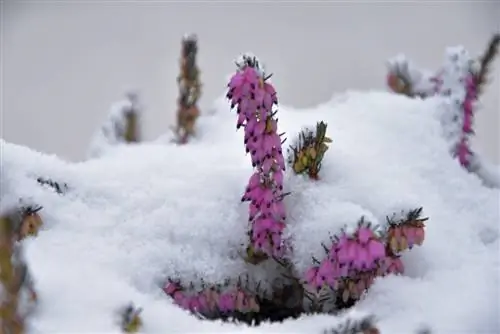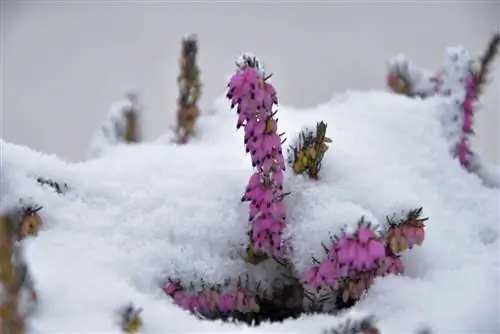- Author admin [email protected].
- Public 2023-12-16 16:46.
- Last modified 2025-01-23 11:21.
With its compact, tightly upright growth, heather is a guarantee for the colorful autumn spectacle in the bed and on the balcony. Home gardeners are right to wonder whether the lavish blooms are limited to a single season. Find out here what the winter hardiness of Besenheide is like. Our tips get to the heart of how to properly overwinter Calluna vulgaris.

Is common heather hardy?
The winter hardiness of common heather (Calluna vulgaris) depends on the quality of the location. The plant is hardy in full sun to shady locations, nutrient-poor, humus-rich soil, moderate drought and an acidic pH value of 4 to 5. Potted plants need additional winter protection.
Location quality determines winter hardiness - that's what matters
Broom heather is a typical plant of the north with extensive, sun-drenched landscapes, characterized by sandy, lean, acidic soil. In its native range, Calluna vulgaris is completely hardy and lives up to 40 years. The closer the location qualities of your garden come to the following conditions, the more winter hardiness develops:
- Full sun to shaded location
- Low-nutrient, humus-rich soil
- Moderately dry to fresh, without risk of waterlogging
- Acidic pH value from 4 to 5
Besenheide is therefore the ideal candidate for designing a heather garden. However, if you integrate a Calluna vulgaris into the perennial bed with nutrient-rich, calcareous soil, it will only make a short guest appearance in your garden.
Winter protection is mandatory in boxes and buckets - this is how it works
Thanks to its delicate growth habit with a height of 15 to 30 cm, common heather is a welcome guest in pots and flower boxes on the balcony. Of course, limited winter hardiness must be observed in plant containers because the root balls are vulnerable to frost and icy wind. The following winter protection measures are recommended:
- Cover pots and boxes with bubble wrap, jute ribbons or coconut mats
- Containers on wood or polystyrene plates to protect against cold floors
- Cover the substrate with autumn leaves, bark mulch or wood chips
Professional winter protection includes careful care. Since evergreen heather evaporates moisture even during the cold season, water regularly. A quick finger test shows whether the substrate has actually dried out. Pour the lime-free water sparingly to prevent waterlogging.
Tip
Are you wondering how the colorful heather got its name? The profile shows that our ancestors tied the dried shoots together into bunches. This is how sturdy brooms and brushes were created for sweeping floors indoors and outdoors.






